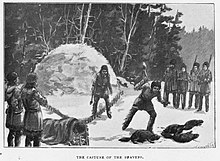
The fur trade in Montana was a major period in the area's economic history from about 1800 to the 1850s. It also represents the initial meeting of cultures between indigenous peoples and those of European ancestry. British and Canadian traders approached the area from the north and northeast focusing on trading with the indigenous people, who often did the trapping of beavers and other animals themselves. American traders moved gradually up the Missouri River seeking to beat British and Canadian traders to the profitable Upper Missouri River region.
Indigenous peoples reacted to fur traders in a variety of ways, usually seeking to further their own interests in these economic dealings.[2] Many times, various tribal groups worked well with traders, but sometimes, especially when indigenous interests were threatened, conflicts developed. The best example of conflict on the Upper Missouri was between American fur traders and trappers and the Blackfeet, particularly the Blood. Misunderstanding of indigenous peoples' interests by American traders inevitably led to violence and conflict.[3]
Ultimately, the fur trade brought increased interactions between indigenous peoples and people of American and European ancestry. A capitalistic economic system was introduced to indigenous peoples impacting their cultures, along with deadly diseases that took a heavy toll in lives. The beaver population, and later the bison, were significantly diminished in the area that became the territory of, and subsequently, the state of Montana.
- ^ Young 1899, p. 228.
- ^ Binnema 2006, pp. 327–349.
- ^ Binnema & Dobak 2009, pp. 411–440.